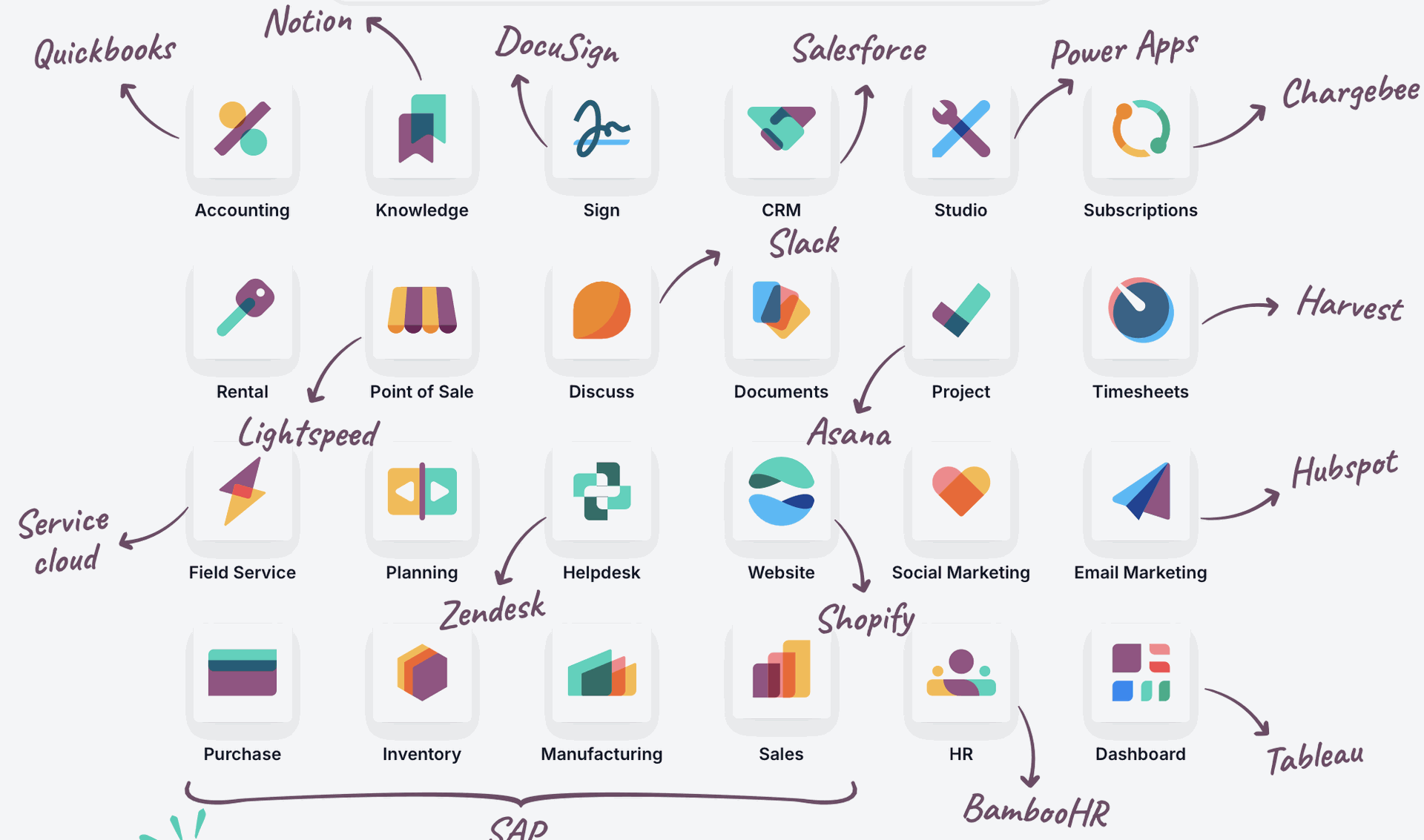Most growing companies don’t start with an ERP. They assemble a toolkit—one app for accounting, another for projects, another for HR—until the “stack” looks like a patchwork quilt. The image below is a snapshot of that reality: each square is a core business function; each handwritten label is a separate product you’d typically bolt on to cover the gap.
What you do without Odoo:

Here’s what that stack often looks like in the wild:
- Accounting → QuickBooks
- Internal wiki / SOPs → Notion
- E-signatures → DocuSign
- CRM → Salesforce
- Low-code tweaks → Microsoft Power Apps
- Subscriptions/Billing → Chargebee
- Timesheets → Harvest
- Email marketing → HubSpot
- Dashboards/BI → Tableau
- HR → BambooHR
- Ecommerce / Sales → Shopify
- Project management → Asana
- Helpdesk → Zendesk
- POS → Lightspeed
- Field Service → Service Cloud
- Chat/Collaboration → Slack
Estimated ~$420/User/Month Compared to Odoo's $46.70/User/Month
That’s 15+ vendors before you’ve even touched inventory, manufacturing, purchasing, or planning.
The Hidden Cost of a Patchwork Stack
1) Data silos
Your customer exists in five places: CRM, email marketing, helpdesk, billing, and accounting. Keeping those records in sync is fragile and error-prone.
2) Integration overhead
Every connection is a mini-project. APIs change, webhooks fail, tokens expire, data types don’t match. Someone becomes the “chief glue officer.”
3) Reporting gaps
Leadership asks a simple question—“What’s our margin by channel last quarter?”—and it turns into a scavenger hunt across spreadsheets and exports.
4) Context switching
Teams bounce between tabs and logins. Work slows, accountability blurs, and training new hires takes longer.
5) Vendor risk & compounding cost
Price increases, feature limits, and roadmap shifts stack up across many providers. You’re negotiating and renewing all year long.
For small and midsize businesses, the hidden cost of a patchwork tech stack can quietly drain hundreds of thousands—sometimes millions—of dollars each year. Productivity losses from context switching alone can reduce output by up to 40%, with studies showing this can equate to over $50,000 per employee annually.
Add to this the vendor risk of price increases and contract churn, plus the high cost of employee turnover—often 30% to 200% of an annual salary due to frustration with poor workflows—and the total annual impact for a 50-person company can easily exceed $500,000. This is money lost not because the business lacks talent or opportunity, but because its systems aren’t designed to work together.
A Day in This World
- Sales logs a deal in Salesforce.
- Billing spins up a subscription in Chargebee.
- Accounting reconciles the payment in QuickBooks.
- Support opens a ticket in Zendesk.
- The PM creates tasks in Asana and chases timesheets in Harvest.
- Marketing emails the customer via HubSpot.
- Leadership asks for a single view in Tableau, which depends on yesterday’s CSV exports.
None of these steps are wrong. They’re just disconnected by default.
Why Teams Move to a Unified Suite (and What That Changes)
When core apps live on the same platform, three things happen:
- One record of truth – Customer, product, order, invoice, and support history are naturally linked.
- Native workflows – Quotes become orders, orders become invoices, invoices trigger fulfillment—without duct tape.
- Trustworthy reporting – Because the data sits together, cross-functional KPIs are a click away, not a month-end project.
Before buying another point tool, map your current stack:
- List each function (accounting, CRM, projects, helpdesk, HR, ecommerce, POS, field service, inventory, MRP, purchasing, planning, marketing, BI).
- Note which vendor covers it, how it integrates, and what breaks when it fails.
- Highlight duplicate data, manual handoffs, and any report you can’t generate in under five minutes.
That exercise will quickly reveal what the image illustrates: the real cost isn’t just subscription fees—it’s complexity. Reducing that complexity is where an integrated platform earns its keep.
A Simple Next Step: If you’d like a fresh set of eyes on your current tech stack, 616 Solutions offers a free consultation to walk through your map, spot hidden inefficiencies, and explore how integration could give you back more time and clarity.